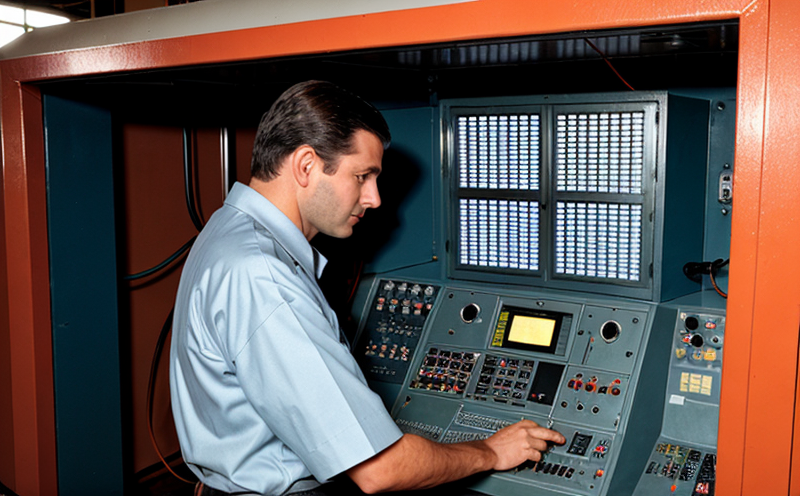Control panel inspection
The control panel is a critical component in lifting equipment and cranes. It serves as the central nervous system of these machines, managing their operation, ensuring safety, and optimizing performance. Quality managers and compliance officers rely on thorough inspections to ensure that these panels function as intended without compromising safety or efficiency.
Control panels must adhere to strict standards such as those set by ISO 13850 for safety-related parts of machinery and EN 954-1 for lifting equipment. These standards outline the necessary checks, tests, and documentation required for a control panel inspection. R&D engineers and procurement professionals need to be aware of these standards to ensure that they are selecting and maintaining equipment that meets industry best practices.
The purpose of inspecting a control panel is not only to check its physical condition but also to evaluate the integrity of the software, hardware, and communication systems it controls. This ensures that all components work together seamlessly to operate the crane or lifting equipment safely and effectively. In this service, we focus on ensuring compliance with relevant standards and protocols while providing detailed reports on our findings.
Our inspection process begins with a visual assessment of the control panel itself. We look for signs of wear and tear that could indicate potential issues down the line. Following this, we conduct a thorough examination of the software embedded within the panel to verify its functionality and security. Additionally, we test communication interfaces between various parts of the system to ensure seamless operation.
During our inspection, we use advanced diagnostic tools to identify any faults or anomalies that may not be immediately apparent during a visual assessment alone. These tools allow us to delve deeper into the internal workings of the control panel and provide more accurate insights than would otherwise be possible with just a surface-level examination.
To ensure complete coverage, our team also checks the integration between the control panel and other critical components such as sensors, actuators, and limit switches. This holistic approach ensures that every aspect influencing safe operation is accounted for in our report.
Scope and Methodology
| Aspect | Description |
|---|---|
| Visual Inspection | Initial examination of the control panel for visible signs of damage or wear. |
| Software Evaluation | Assessment of software embedded within the panel to ensure functionality and security. |
| Communication Testing | Testing communication interfaces between different parts of the system to ensure seamless operation. |
| Advanced Diagnostics | Use of specialized diagnostic tools to identify hidden faults or anomalies. |
| Sensor and Actuator Integration | Checking the integration between the control panel and other critical components like sensors, actuators, and limit switches. |
The methodology for inspecting a control panel involves several steps. First, we perform an initial visual inspection of the panel to identify any obvious signs of damage or wear. Next, we evaluate the software within the panel using appropriate diagnostic tools to ensure it is functioning correctly and securely. We then test communication interfaces between various parts of the system to guarantee smooth operation.
Following this, advanced diagnostic techniques are employed to uncover any hidden faults or anomalies that might not be apparent during a surface-level examination. Finally, we check the integration between the control panel and other crucial components such as sensors, actuators, and limit switches to ensure they work together flawlessly.
Industry Applications
The importance of control panel inspections cannot be overstated in industries where lifting equipment and cranes play a vital role. Construction firms depend heavily on these machines for moving materials around job sites safely and efficiently. By ensuring that the control panels are functioning properly, we help prevent accidents caused by mechanical failures or operator error.
In manufacturing plants, reliable crane systems contribute significantly to productivity levels. Through regular inspections of their respective control panels, manufacturers can maintain optimal performance standards, thereby reducing downtime and increasing overall efficiency.
Ports and harbors also benefit greatly from this service due to the large volumes of cargo they handle daily. Properly maintained cranes at these locations enhance safety while facilitating timely loading and unloading operations.
Environmental and Sustainability Contributions
- Avoidance of mechanical failures leading to prolonged downtimes which can result in higher energy consumption during repairs.
- Promotion of safe working practices, reducing the risk of accidents that could lead to environmental pollution.
- Enhanced efficiency resulting from optimized operation of lifting equipment and cranes contributes positively towards resource conservation efforts.
The control panel inspection service plays a crucial role in promoting sustainability within our clients' operations. By preventing mechanical failures, we help reduce unnecessary energy consumption during repair processes. This not only saves costs but also reduces the environmental impact associated with these activities.
Moreover, by fostering safe working practices that minimize the risk of accidents, we contribute to maintaining cleaner environments both on-site and off-site. Safe operations prevent spills or leaks from occurring, which could otherwise contaminate soil or water bodies nearby.
Efficiently operated lifting equipment and cranes also lead to better resource utilization. With minimal downtime, more goods can be transported over longer periods without compromising safety standards. This increased productivity helps businesses operate more sustainably by making the best use of available resources.





